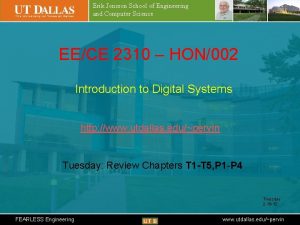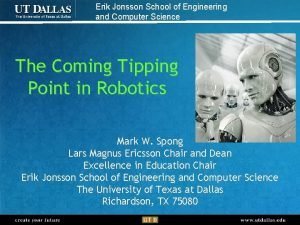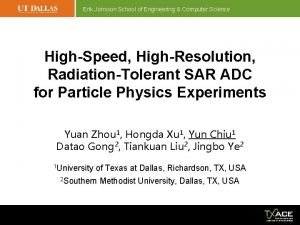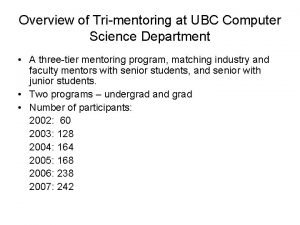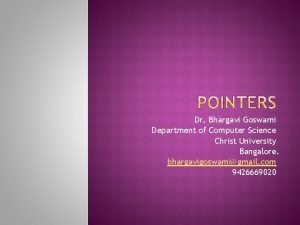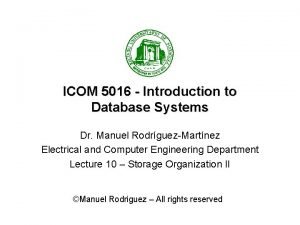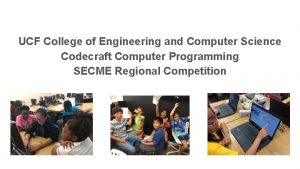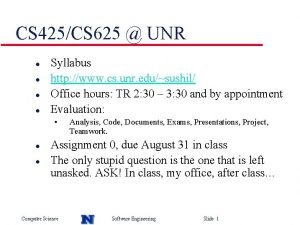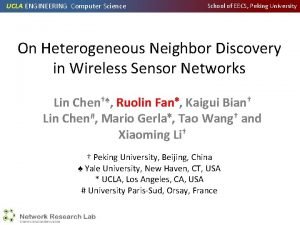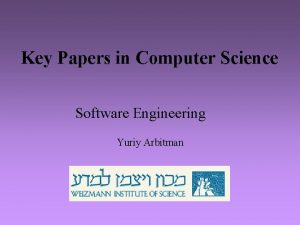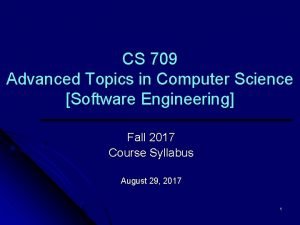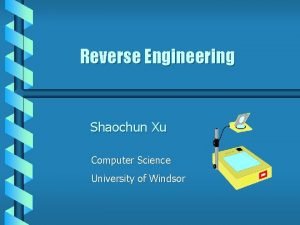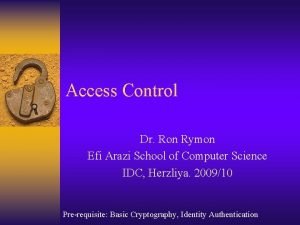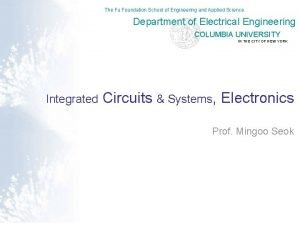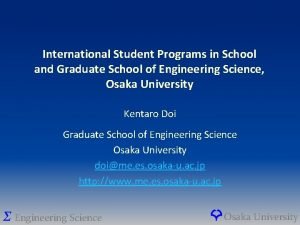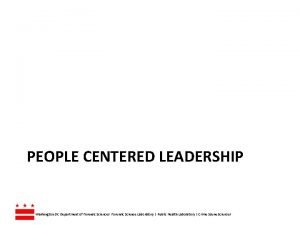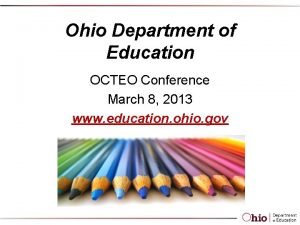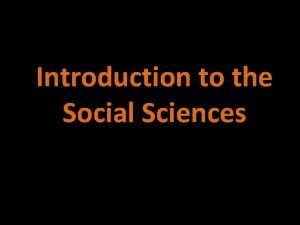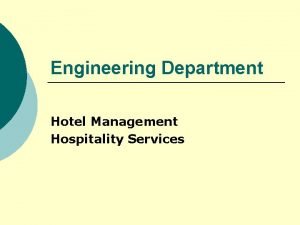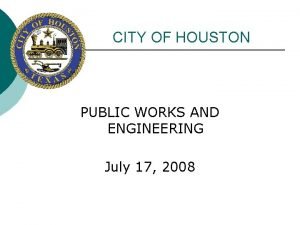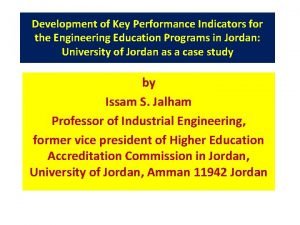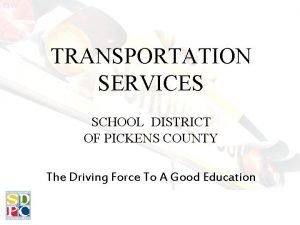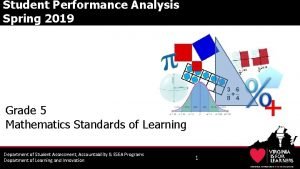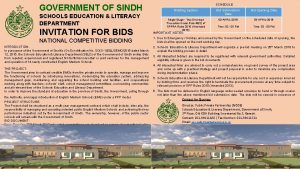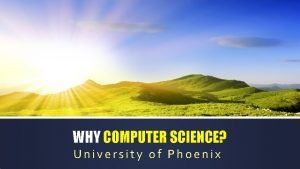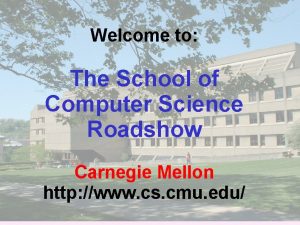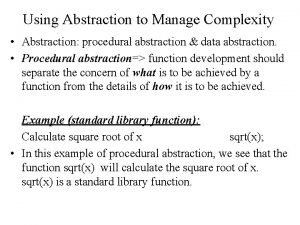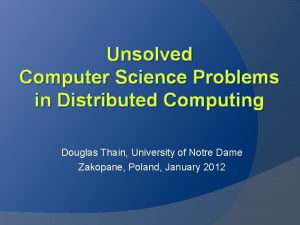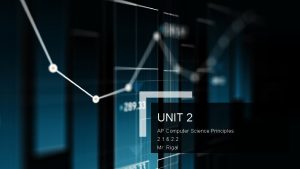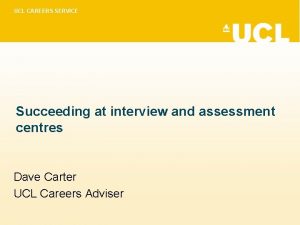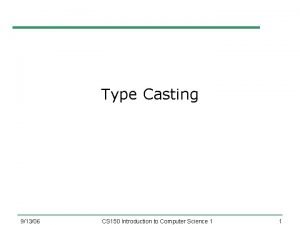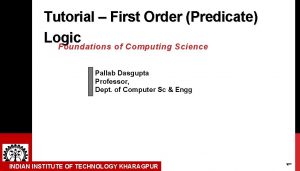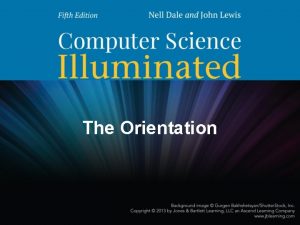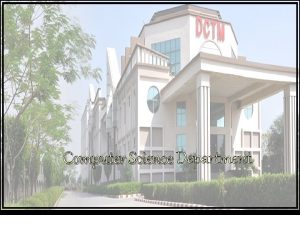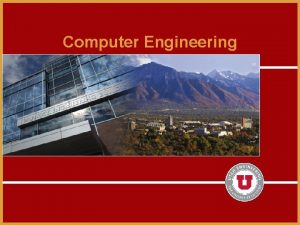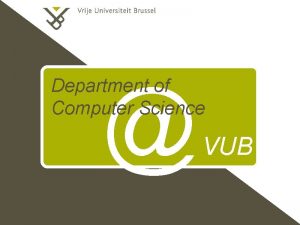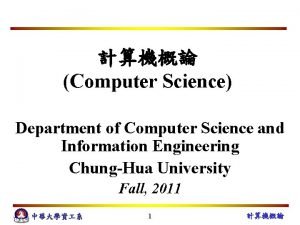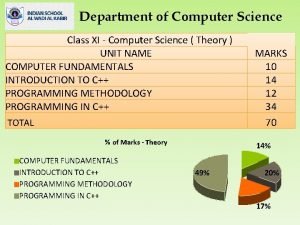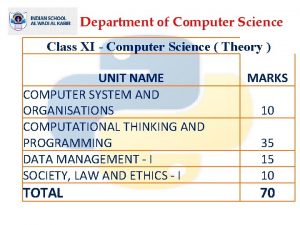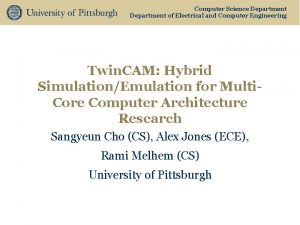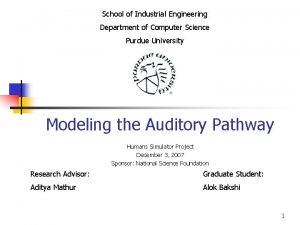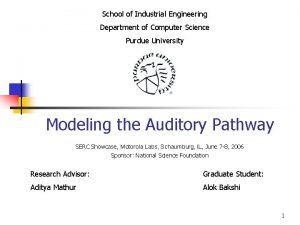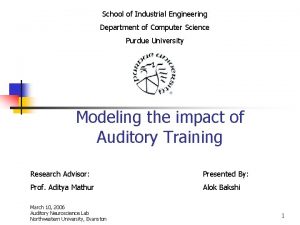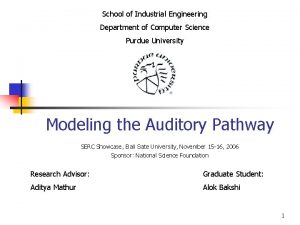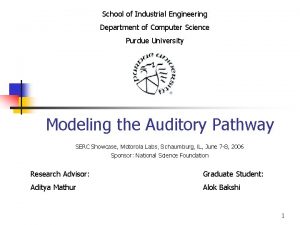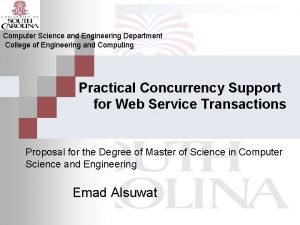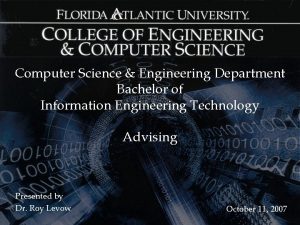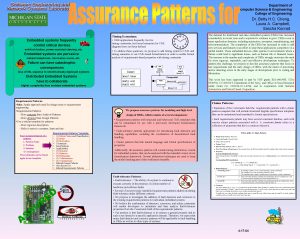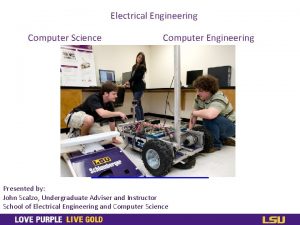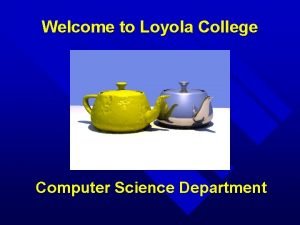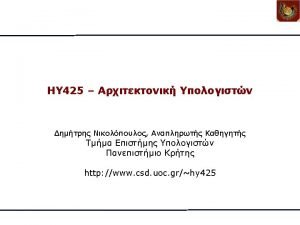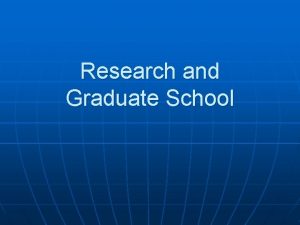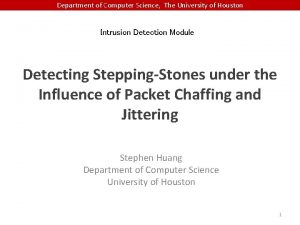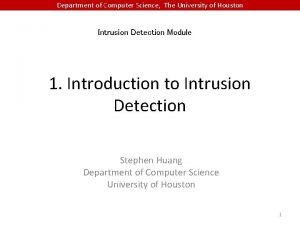School of Engineering Computer Science Engineering Department Outline


































































- Slides: 66

School of Engineering Computer Science & Engineering Department

Outline 1. UB Profile 2. SE Profile 3. CSE Profile School of Engineering University of Bridgeport

Welcome to Bridgeport • Located between New York City (60 miles) and Boston (150 miles) • Accessible by car, rail, air and ferry • Connecticut’s largest city Several local hotels (Holiday Inn, Marriott, etc. ) • • Nearest airports: JFK (64 miles), Laguardia (60 miles), Hartford (70 miles), Newark (75 miles)

Bridgeport • Diverse people and cultures • Tourist Attractions – P. T. Barnum circus museum – Discovery museum and planetarium – Beardsley Zoo – Downtown cabaret theater – Bridgeport Bluefish (Baseball) and Sound Tigers (Ice Hockey)

University of Bridgeport Ø Founded in 1927 Ø Accredited, private, doctoral level institution Ø Located in the state of Connecticut, city of Bridgeport Ø Student body representing over 80 countries 5

University of Bridgeport • • • An international, doctoral intensive comprehensive university, with award-winning academic programs. UB’s 50 -acre campus is flanked by the Seaside Park and Long Island Sound Ideally located – Beaches 2 -3 minute walk – Close to metro north rail station

University Profile • University of Bridgeport founded in 1927 as the Junior College of Connecticut • Became the University of Bridgeport in 1947 • Private, Independent, Non-sectarian and International • UB Total Full Time Students : 5300 approx School of Engineering University of Bridgeport

ENROLLMENT (Since 1992…) 4, 752 4, 018 4, 000 3, 626 3, 000 2, 000 1, 383 1992 1994 1996 1998 2000 2002 2004 2005 2006 2007 TOTAL 2000 2001 2002 2003 2004 2005 2006 2007 Growth 2, 973 3, 162 3, 173 3, 165 3, 274 3, 626 4, 018 4, 752 60%

UB Schools School of Arts & Sciences School of Business School of Engineering School of Education & Human Resources International College School of Continuing & Professional Studies College of Chiropractic Fones School of Dental Hygiene College of Naturopathic Medicine Nutrition Institute Acupuncture Institute ELI – English Language Institute 9

University Campus

University Surroundings

School of Engineering Fastest growing School of Engineering in the nation, among the 300+ accredited engineering schools Largest graduate engineering program in Connecticut (over 1000 students) and second largest graduate engineering program in New England

School of Engineering • The SOE offers undergraduate degrees in Computer Science and an ABET-accredited Computer Engineering degree. • Master's degrees in Electrical Engineering, Computer Science, Mechanical Engineering, Biomedical Engineering and Technology Management. • Ph. D. degree in Computer Science and Engineering.



ENGINEERING “UB’s Engineering School, with 1, 250 students, is among top three for enrollment in New England. ” CT Post 11/22/2007

Conferences • The School of Engineering has been the host of the largest international engineering research conference held on line for the last three years. CISSE (The International Joint Conferences on Computer, Information and Systems Sciences and Engineering) is the first high-caliber Research Conference in the world to be completely conducted online in real-time via the internet. • The School of Engineering recently started to host a colloquium series with vibrant and renowned speakers. Five internal and five external speakers are scheduled for every semester. This series has attracted regional attention and features world-class scholars and industry pioneers. In April 2008, the SOE hosted the IEEE Computer Society Spring Workshop. • The School of Engineering has been chosen to host two major international and regional conferences in 2009: • REV (Remote Engineering and Virtual Instrumentation) • ASEE (American Society for Engineering Education)

MS – Technology Management Curriculum & Choices* TM Core Courses * • Marketing, Entrepreneurship & Innovation • Total Quality Management & Continuous Process Improvement • Finance & Accounting for Managers • Leadership, Teams and Managing Change • Global Program and Project Management • Business Policy and Strategy – Capstone / Project • Contemporary Issues in Communications and Quantitative Techniques • Engineering Colloquium (1 credit) Required Courses: 8 Courses for Degree Choice of Concentrations & Electives (27 Choices)** • Bio-Technology and/or Bio-Medical Management and Technology • Computer, Networking & Software • Data Base Management Systems • Electronic Commerce & Information Technology • Entrepreneurship • Environmental & Energy Management • Health Care Management & Administration • New Venture Creation/Entrepreneurship/ Intrapreneurship • Manufacturing Management • New Product Development & Commercialization • Program & Project Management • Service Management & Engineering • Strategic Sourcing & Outsourcing • Supply Chain & Logistics Management • +++++ 4 Electives – Can be chosen *Minimum Total Credits Required = 34 for Graduation

Research Areas – Technology Management • • • • Creating and Sustaining Innovation and Managing Proactive Change Bio-Medical/Bio-Technology and Management Business and Information Technology Continuity and Security Environment and Energy Management and Technology (including Green and Sustainability) Entrepreneurship, Intrapreneurship & New Venture Creation Creating & Sustaining High Performance Global Leaders and Teams New Product/Service Development and Commercialization Strategic Marketing, Demand Creation and Growth Information Technology Outsourcing and Strategic Sourcing Quality Management and Lean Process Management Global Program and Project Management Supply Chain Management & Logistics Corporate and Information Technology Strategy, Execution & Governance Manufacturing Management Service Management

MS – Computer Science Curriculum * CS Core Courses Choice of Electives • Computer Networks • Advanced Object Oriented Programming Using C++ • Algorithm Design • Operating Systems • Data Base Design • Data and Computer Communication • Graduate Project • Engineering Colloquium (1 credit) Required Courses: 7 Courses for Degree • • • • Local Area Networks Network Administration Advanced Data Base Design Multimedia Data Base Design Windows Programming Unix System Programming Services Oriented Architecture Java Programming Advanced java Programming Computer Architecture Robotics Advanced Robotics Mobile Communication Wireless Communication 5 Electives Must Be Chosen

MS – Computer Engineering Curriculum * CS Core Courses • Advanced Object Oriented Programming Using C++ • Digital Signal Processing • Computer Architecture • Logic Synthesis Using FPGAs or VLSI Design • Data and Computer Communication • Graduate Project • Engineering Colloquium (1 credit) Required Courses: 7 Courses for Degree Choice of Electives • • • • Computer Networks Local Area Networks Network Administration Analog VLSI Design VLSI (Very Large Scale Inegration) Windows Programming Unix System Programming Image Processing Software Engineering Java Programming Network Security Robotics Advanced Robotics Mobile Communication Wireless Communication 5 Electives Must Be Chosen *Minimum Total Credits Required = 34 for Graduation

Research Areas - Computer Science & Engineering • • • • Automation and Manufacturing Biomedical Engineering Computer Architecture Computer Arithmetic Computer Networks Control Systems Digital Signal Processing & Image Processing Multimedia Data Base Application Formal Approaches for Design, Synthesis and Verification Parallel and Distributed Architectures and Algorithms Robotics Scalable Web Architectures, SOA, GPS Applications. Microelectronic Design Wireless Communication

MS – Electrical Engineering Curriculum & Choices* § Core courses are decided by the student pursuing a particular concentration; courses come from a list of almost 100 different courses; student should be guided by the department's research areas. § All courses are at the 400 or 500 level. § All courses in EE and Computer Science and Computer Engineering are accepted toward the MSEE. § A minimum of 30 credits is required for the MSEE § Master's Project or Thesis is required § One course in either Technology Management or Mechanical Engineering may be taken, but this is not necessary. § Concentrations available in Electrical Engineering are: VLSI, Signal Processing, Energy and Power, Medical Electronics, Solar Cells, Electrical Accident Reconstruction, MEMs, Electrical materials/Composites, PLC (Programmable Logic Control)

Research Areas - Electrical Engineering • • • • Distributed control and optimization Electrical Properties of Plastic/Metal Composites Electrical Safety and Electric Accident reconstruction Electromagnetic Fields Applied To Lightning Electronic Biological Sensors Electronic Materials and Devices Information processing and control of large-scale distributed systems Medical Electronics & Bio-Medical Micro-electromechanical Systems (MEMS) Micro-sensors and Micro-actuators Superconductors Thin-film Solar Cells VLSI design and testing PLC (Programmable Logic Control) 24

MS – Mechanical Engineering Curriculum & Choices* ME Core Courses • Traditional Concentration Area • MEEG 410 Advanced Fluid Dynamics • MEEG 452 Advanced Vibration • MEEG 453 Finite Element Methods • MEEG 454 Advanced Dynamics • MEEG 463 Advanced Heat Transfer • Math 401 Advanced Analysis • Master’s Project • Engineering Colloquium (1 credit) Choice of Concentrations Design Management Concentration Area (Take 3 credits from Traditional Core Courses) • Computer Aided Engineering/Design • Advanced CAE/CAD Projects • CAM & NC Machining • Design & Innovation • Ergonomics • Intellectual Property & Technology Manufacturing Management Concentration Area (Take 3 credits from Traditional Core Courses) • Materials & Methods in Manufacturing • Advanced CAE/CAD Projects • Innovations & Product Development • Production Technology & Techniques • Supply Chain Management • Principles of Logistics and Materials • Manufacturing Management • Robotics and Automation • Materials *Minimum Total Credits Required = 30 for Graduation

Research Areas – Mechanical Engineering • • • • • Automation control Biomechanics of manipulation Biomedical equipment design Design/Shape optimization Computational fluid dynamics Finite element analysis HVAC Heat Transfer Human performance effects of manipulation of the extremities Laser material processing Manufacturing Nanomaterials Biomaterials and bioinspired materials Prototyping Robotics Thermal management of electronic devices and systems Welding BIM – Building Information Modeling

MS – Biomedical Engineering Curriculum & Choices* § Core courses are decided by the student pursuing a particular concentration; courses come from a list of several interdisciplinary biomedical engineering courses student should be guided by the BME program research areas. § All courses are at the 400 or 500 level and research project is 600 level. § Many courses in EE, Computer Science and Computer Engineering, TM and ME are accepted in MS BME program. § A minimum of 33 credits is required for the MSBME § Team based research project of 6 credit is compulsory § Concentrations available in Biomedical Engineering are: Biomaterials, Tissue Engineering, Bioelectronics and Biomedical Electronics, Biobased Energy and Power, Bio-MEMs, Biosensing, Bioimaging, Biomechanics, Bio-instrumentation, Biorobotics, Electrochemistry in biosystems, Bio-signaling, Communication in biological systems

Research Areas – Bio-Medical Engineering • • • • • Biomedical materials Biomimicking and bioinspired materials Bioelectronics Bio. MEMS Biosignal processing Biorobotics Bioimage processing Ergonomy Bioinformatics Gene sequencing Communication in man-machine interface Biosensing Tissue Engineering Cellular and molecular biology Biometrics Biomechanics Biotechnology

Financial Stipends and Scholarships v 165 Engineering and Business programs assistantships based on academic merit: 4 credits tuition waiver for two consecutive semesters v Dean’s Assistantships: 9 credits tuition waiver and $10, 000 living costs waiver for two consecutive academic semesters for Engineering v Graduate Assistantships, Research Assistantships and Student Workers employment available v Payment plans option available after your 1 st semester

Facilities

Facilities • 16 state of the art computer/instruction labs. • Sample of Distinguished Research labs: – RISC Project Lab. (Interdisciplinary Robotics, Intelligent Sensing, and Control): Director Prof. Tarek Sobh – Wireless & Mobile Communications (WMC) Project Lab. : Director Prof. Khaled Elleithy – VLSI/FPGA Project Lab. – Multimedia Information Group (MIG) Project Lab. : Director Prof. Jeongkyu Lee – PLC Lab. : Director Prof. Jack Toporovsky

Multimedia Information Group (MIG) Laboratory

UNIVERSITY OF BRIDGEPORT MIG@UB Multimedia Information Group • Multimedia Information Group @ UB – Department of Computer Science and Engineering at UB, CT • Location: Charles A. Dana Hall #234 • People – Prof. Jeongkyu Lee – 2 Ph. Ds and 2 MS students • Collaborators – Prof. Jung. Hwan Oh at UNT – Prof. Shou-jiang Tang at UTSW – Prof. Dongwon Lee at PSU http: //www. bridgeport. edu/~jelee/mig

UNIVERSITY OF BRIDGEPORT Our Vision Multimedia Information Group http: //www. bridgeport. edu/~jelee/mig

UNIVERSITY OF BRIDGEPORT Multimedia Information Group Active Research Tae. Kwon. Do project Smart. View project • Developing algorithms and S/W for event detections from WCE (Wireless Capsule Endoscopy) videos • Funded from Intro. Medic, Co. Ltd. , Korea • Collaborator: Dr. Tang at UTSW, Dr. Oh at UNT • Developing algorithm and prototype system for automatic judge of Tae. Kwon. Do poomsae • Sponsor: International College at UB, WTF • Collaborator: Prof. Kim of Martial Art dept. at UB MIG • Developing a noble method for video and image matching • Applicatoin 1: Video Copy Detection for You. Tube • Applicatoin 2: BIM (BLASTed Image matching) • Collaborator: Dr. Dongwon Lee at Penn State University Vlinkage: Video Linkage project • Developing a new algorithm for automatic generation of Multimedia Ontology • Target applications: Medical videos, Surveillance camera, and Military videos • Looking for sponsors Multimedia Ontology http: //www. bridgeport. edu/~jelee/mig

University of Bridgeport School of Engineering Robotics, Intelligent Sensing and Control Lab (RISC)

Outline of Outgoing Project • Online Automation and Control: An Experiment in Distance Engineering Education • E-Learning: Case Studies in Web-Controlled Devices and Remote Manipulation • Prototyping Environment for Robot Manipulators • Manipulator Workspace Generation and Visualization in the Presence of Obstacles • Kinematic Synthesis of Robotic Manipulators from Task Descriptions • New concept in optimizing the manipulability index of serial Manipulators using SVD method

Outline of Outgoing Project • Recovering 3 -D Uncertainties from Sensory Measurements for Robotics Applications • Industrial Inspection and Reverse Engineering • Sensing Under Uncertainty for Mobile Robots • Robot Design and Dynamic Control Simulation Software Solutions From Task Points Description. • RISCBot II

Online Distance Laboratories • • Using Automation and Telerobotic (controlling devices from a distance) systems Real-time laboratory experience via the internet 1. Tele-operation of Mitsubishi Movemaster 2. RISCBOT – A Web Enabled Autonomous Navigational Robot 3. Tele-operation of the FESTO Process Controller

Capabilities and Research Facilities • • • Sensing under uncertainty. Sensor-based distributed control schemes. Control and planning for autonomous mobile systems. Modeling and recovering uncertainty in 3 -D structure and motion. Dynamics and kinematics generation and analysis for multi-DOF robots. Active observation and control of a moving agent under uncertainty. Automation for genetics application. Manipulator workspace generation in the presence of obstacles. Turbulent flow analysis using sensors within a DES framework

Other Projects RISC

RISC

Workspace Dimensions and Coordinates of the Task-Points Restrictions on Manipulator Configuration Velocity and Acceleration Requirements Obstacles, Working Medium, and Trajectory Biases


Manipulability Bands of Puma 560 in 2 D workspace


RISCbot II

Wireless & Mobile Communications (WMC) Laboratory

Current Research Projects 1. Wireless Multiuser Communications for Cellular and Mobile Networks • • BER and SNR Analysis of DS-CDMA Cellular Networks Multiple Access interference (MAI) Cancellation for Wireless Multiuser Receivers Analysis of Processing Gain for Wireless Multiuser DS-CDMA Systems Computational Complexity and Algorithm Optimization for 3 G Cellular Networks

Research Projects 2. Wireless Mesh Networks • The Use of Orthogonal Frequency Code Division (OFCD) in Broadband Wireless Mesh Networks • Efficient Routing Algorithms for Wireless Mesh. Hypercube (M-H) Networks

Research Projects (Cont. . ) 3. Mobile Ad Hoc Networks (MANET) • • • The Best and Worst Case Capacity Analysis of MANET Efficient DSR Based Routing Scheme for MANET Minimizing the Malicious Behavior of Mobile Nodes for Maximizing the MANET Data Throughput 4. Wireless Sensor Networks 1. Resource Optimization in Wireless Sensor Networks Via Self-Adaptive Methodology 2. Minimizing the Energy Consumption of Wireless Sensor Nodes Using Active Node Optimization Method

Related Recent Results CDMA Receiver: Multiuser Receiver • • • A class of CDMA receivers known as multiuser receivers It exploit the available information about the spreading sequences and mobile channel impulse responses of all the CDMA users The goal is to improve the performance of the wireless CDMA users WMC research group focuses on this part Classification of CDMA detectors

Related Recent Results Antenna Design for Cellular Networks • Advantages – Co-channel interference reduction – Collect multipath components – Delay spread reduction – reduce handoff rate – stand alone technique • Disadvantages – Linear increase in Interference – Cancel only L-1 interference – Difficult to achieve convergence in low SNR WMC research group focuses on the utilization of adaptive antenna array with CDMA systems for achieving optimal performance Figure: Adaptive Antenna Array

Faculty • The School of Engineering currently has more than 75 full and part time faculty members. The number of full time faculty has doubled in the past four years. • The School of Engineering faculty have produced more than fifteen books in the past two years on topics varying from Engineering Education, Computing Sciences and Software Engineering, ELearning, Instruction Technology, Algorithms and Techniques in Automation, Robotics, Industrial Electronics and Telecommunications • The number of faculty and student scholarly publications in worldclass academic conferences and journals in the last three years has been over 400.

School of Engineering • UB Among U. S. Doctorate Granting Institutions: Seventh most diverse University Seventh (small class sizes) Second most international University (U. S. News and World Report Rankings) • School of Engineering: Most diverse and international in UB; small class sizes.

Computer Science & Engineering Department • Students • Faculty • Laboratories • Collaboration with Industry • Research • Recent Achievements • Unique Characteristics

Students • High percentage of international students. • Very active and high quality : • High grades, co-ops, internships, publishing and research (graduates and undergraduates), tutoring, awards, entrepreneurial activities. • CSE Department is largest in School of Engineering.

Faculty • Faculty background in CS , CE, MATH, and EE • Small Faculty, but very active in research, new program / course development, industry involvement, teaching innovation, consulting. • publishing in quality journals and conferences • attracting external funds, entrepreneurial activities. • Distinguished teaching + innovative instruction • 2002 UB Distinguished teacher of the year award • Developing new courses and materials, web resources , labs, programs (e-content , e-assessment, distance learning programs, etc. . ) • Collaboration with industry

Laboratories Significant instructional / R&D Labs. in the areas of: • • Robotics / Automation and Control. Advanced digital design and VLSI / FPGA. Advanced networking and telecommunications. Wireless communications. High Performance Computing. Power Electronics and others. Moving to a newly renovated building in 2001 (new home for Engineering at UB) • Compute count : 100 + Sparcs, 130+ PC’s; S/W. . )

Research • Grants for Equipment, Research and Development. (Helped in Establishing our labs. ) • Several R & D projects in the areas of: • Automation and Robotics. • Product Design and Prototyping. • Signal Processing. • VLSI. • Motion Control. • Manufacturing / Reverse Engineering. • Software Development.

Teaching and Innovative Programs • Evening, weekend and continuing education • On-site teaching in Industry. • Distance learning version of M. S. in C. S. • 3 - 4 Course graduate and undergraduate certificates

Industry and Community Collaboration • • • Co-ops and internships Joint development projects. On-site Training Industry Advisory Board Conn. Cap Program (Pre-Engineering) with Bridgeport School District and the School of Education. Sample of Companies: Sagemaker, EMC, Pitney Bowes, Northrup Grumann, ADC Newnet, Dictaphone, Transwitch, Executone, Motorola, Sony, Lucent, Synopsis, NEC, Oracle, General Re, Lockheed Martin, IBM, UPS, SNET, Remington, Sikorsky Aircraft and others.

Recent Achievements • 4 American Society of Engineering Education (ASEE) awards in the last three years • ACM (Association of Computing Machinery) regional competition: top 3 - 5 placements for several years. • Faculty research / best paper awards and grants. • Recent Lab. upgrades and grants (Sun Microsystems $0. 7 M grant, Oracle $1 M grant, NSF Lab. Grant, others) • Connecticut Venture Group (second place, statewide) • Sigma Xi research grant, 3 Upsilon Pi Epsilon awards, Phi Kappa Phi, Microsoft, IEEE CSIDC awards.

Unique Characteristics • 1 out of 2 ABET-accredited Computer Engineering • • programs in Connecticut. (1 out of 8 -10 in New England) One of the largest CS-Graduate program in CT Only Weekend Masters in Computer Science in Region. (NY, NJ, CT, MA, RI, etc. ) Co-op and internships programs (Virtually all students, graduate and undergraduate) Undergraduate research and publications. National and international awards.

Opening Doors, Building Futures University of Bridgeport - strongly committed to academic development and professional accomplishments!!!

Thank you
 Erik jonsson school of engineering and computer science
Erik jonsson school of engineering and computer science Erik jonsson school of engineering and computer science
Erik jonsson school of engineering and computer science Erik jonsson school of engineering
Erik jonsson school of engineering Meng computer science ucl
Meng computer science ucl Northwestern computer science department
Northwestern computer science department Computer science department rutgers
Computer science department rutgers Stanford vptl tutoring
Stanford vptl tutoring Fsu cs faculty
Fsu cs faculty Trimentoring
Trimentoring Bhargavi goswami
Bhargavi goswami Columbia university department of computer science
Columbia university department of computer science Kerberos iitd
Kerberos iitd Tum department of electrical and computer engineering
Tum department of electrical and computer engineering Computer engineering department
Computer engineering department My favourite subject is science
My favourite subject is science Computer science vs software engineering
Computer science vs software engineering Ucf software engineering
Ucf software engineering Computer science and engineering unr
Computer science and engineering unr Ucla
Ucla Computer science software engineering
Computer science software engineering Computer science software engineering
Computer science software engineering Reverse engineering computer science
Reverse engineering computer science Efi arazi school of computer science
Efi arazi school of computer science Quote one topic sentence
Quote one topic sentence Computer based system engineering in software engineering
Computer based system engineering in software engineering Fu foundation school of engineering and applied science
Fu foundation school of engineering and applied science Graduate school of engineering science osaka university
Graduate school of engineering science osaka university Klipsch school of electrical and computer engineering
Klipsch school of electrical and computer engineering Department of forensic science dc
Department of forensic science dc Ohio department of education science standards
Ohio department of education science standards Understanding science worksheet answers lesson 1
Understanding science worksheet answers lesson 1 Define social science
Define social science Electrical engineering department
Electrical engineering department Engineering department hotel
Engineering department hotel City of houston idm
City of houston idm What is kpi in engineering
What is kpi in engineering Department of information engineering university of padova
Department of information engineering university of padova Department of information engineering university of padova
Department of information engineering university of padova University of bridgeport engineering
University of bridgeport engineering Computer science tutor bridgeport
Computer science tutor bridgeport Ucla systems engineering
Ucla systems engineering University of sargodha engineering department
University of sargodha engineering department Software engineering 1 course outline
Software engineering 1 course outline Pickens county bus transportation
Pickens county bus transportation Sol score range
Sol score range School education and literacy department
School education and literacy department Social science vs natural science
Social science vs natural science Brances of science
Brances of science Natural and physical science
Natural and physical science Applied science vs pure science
Applied science vs pure science Natural science and social science similarities
Natural science and social science similarities Science fusion think central
Science fusion think central Rule of 70 population growth
Rule of 70 population growth Julie lundquist
Julie lundquist Soft science definition
Soft science definition Gcse computer science wjec
Gcse computer science wjec Phoenix online computer science university
Phoenix online computer science university How many fields in computer science
How many fields in computer science Procedural abstraction definition
Procedural abstraction definition Unsolved computer problems
Unsolved computer problems Sequencing ap csp
Sequencing ap csp Ucl careers service
Ucl careers service Casting computer science
Casting computer science Predicate computer science
Predicate computer science Computer science illuminated (doc or html) file
Computer science illuminated (doc or html) file Set theory in computer science
Set theory in computer science Yonsei computer science
Yonsei computer science
